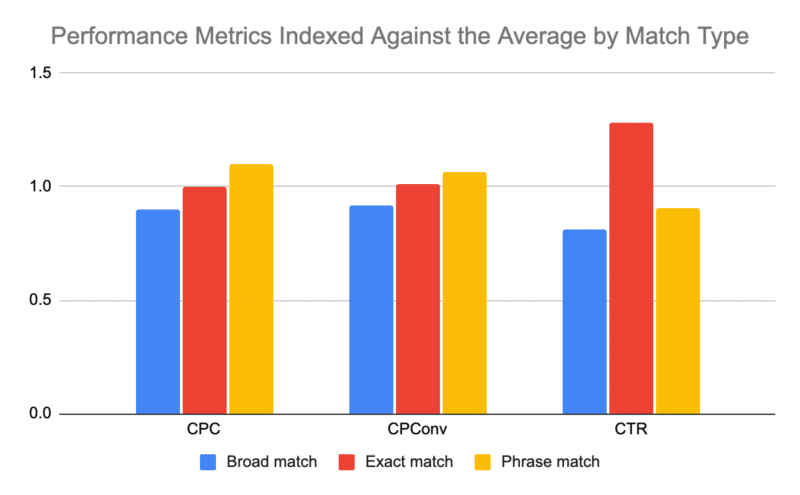Google Ads broad match: What the data reveals for PPC marketers
Embrace the potential of broad match while avoiding common pitfalls. Here's how to use it wisely to reach a wider audience.
“Broad match gives you the most relevant reach and conversions within your performance goals.”
– Google Marketing Live 2023
This is how Google describes broad match in their Google Marketing Live 2023 recap.
Wait, what? Broad match gives the most relevant reach?
PPC marketers know it inherently can’t be the most relevant – or at least that was the conversation within our team at the time.
Our team and clients extensively discussed the idea of a “keywordless” future heading our way, especially in the context of Performance Max campaigns.
We’ve also observed that the exact match type has become more lenient with “close variants.”
This made me want to uncover how paid search accounts perform at the match-type level. Here are some key observations and what they mean for PPC marketers.
Looking at Google Ads account performance per match type

I pulled data across our client accounts for the past 12 months. Here are four key takeaways from my analysis.
Broad match has the lowest CPC
This is expected. The theory is that the less targeted you are, the less competition and the lower the cost.
The data confirmed this theory, showing that the least expensive match type was nearly a dollar cheaper than others.
Exact match drives the highest click-through rate
This data point matches the theory that the more specific you are, the more relevant the ad.
The more relevant the ad copy is for consumers, the higher the response rate.
Phrase match is the worst performing match type with a slight exception for CTR
Poor phrase match. This one seems just trapped like a middle child.
It can’t seem to do anything right. It had the highest CPC and cost per conversion.
It was only slightly better in CTR than broad match, which isn’t really much of an endorsement.
Broad match has the lowest cost per conversion
This one was the most surprising.
However, if broad match has the lowest cost per click, it can have a lower conversion rate and still have the lowest cost per conversion.
That is exactly what the data suggests. Broad match has the lowest conversion rate, but the cost to acquire the traffic offsets the lower conversion rates.

The data suggests that performance has remained fairly consistent with the introduction of more AI tools. There’s no clear indication that users or advertisers use these match types differently over time.
Although I only share CPC data, the other graphs for different data points show similar patterns.

The data showed that only ~11% of the total impression volume accounted for just 8% of the clicks.
Interestingly, exact match had the highest volume of both impressions and clicks.
Considering that broad match had the lowest cost per conversion, I’m keen to analyze the entire data set to identify potential opportunities for performance improvement.

How to use broad match in Google Ads effectively
Broad match can be a great way to reach a wider audience with your ads, but it’s important to use it carefully.
If you use broad match extensively, your ad could show for irrelevant searches, and you could end up wasting money.
Here are some tips for using broad match effectively:
- Use negative keywords to exclude irrelevant searches. For example, if you sell running shoes, you could add “basketball shoes” as a negative keyword to prevent your ad from showing for searches related to basketball shoes.
- Use ad extensions to make your ads more relevant to the searches they show for. For example, if you sell running shoes, you could add an ad extension that shows the different types of running shoes you sell.
- Monitor your results and adjust your campaigns as needed. Keep an eye on your click-through rate (CTR) and cost-per-click (CPC) to see how your ads are performing. You may need to adjust your keyword match types if your CTR is low or your CPC is high.
Make data-driven decisions in your Google Ads account
Broad match can be a powerful tool, but it’s important to use it wisely.
By following these tips, you can leverage broad match to reach a wider audience with your ads and achieve better results in your Google Ads campaigns.
As we move toward a “keywordless” future, the fate of various match types remains to be seen.
For now, data-driven decisions are crucial so we can make smarter optimizations.
Opinions expressed in this article are those of the guest author and not necessarily Search Engine Land. Staff authors are listed here.
Related stories
New on Search Engine Land